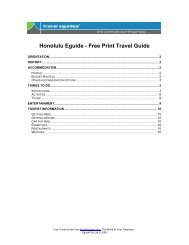Australia Eguide - Travel Guides
Australia Eguide - Travel Guides
Australia Eguide - Travel Guides
You also want an ePaper? Increase the reach of your titles
YUMPU automatically turns print PDFs into web optimized ePapers that Google loves.
152<br />
inches Commonwealth Railways line. In recent times, South <strong>Australia</strong>n Railways<br />
relinquished the operation of its country lines to <strong>Australia</strong>n National Railways, which<br />
promptly stopped operating any country services at all. Thus there are now no intra-state<br />
trains in South <strong>Australia</strong> except for the Adelaide suburban services and the expensive<br />
privately-operated Wine Train to the Barossa Valley.<br />
Longdistance trains through Adelaide are now operated by Great Southern Railway and<br />
consist of the Overland between Adelaide and Melbourne, the Indian-Pacific between<br />
Sydney and Perth via Adelaide and the Ghan between Sydney or Melbourne and Alice<br />
Darwin via Adelaide. As for buses, Greyhound operate from Adelaide to Melbourne,<br />
Sydney, Alice Springs and Perth, and have competition from Firefly and V-Line to<br />
Melbourne, and from V-Line to Sydney via Albury.<br />
This network consists principally of services from Adelaide east to Renmark, south-east<br />
to Mt. Gambier and Bordertown, south to Goolwa and Victor Harbor, north to Moonta,<br />
Port Pirie, Port Augusta, Wilpena, Roxby Downs and Whyalla, and west to Port Lincoln<br />
and Ceduna. There are also some services provided by private operators.<br />
The Wayward Bus offers a service between Adelaide and Melbourne via the coast, a<br />
route which can be covered more cheaply, however, by a combination of Stateliner and<br />
V-Line services, and some careful planning.<br />
Adelaide<br />
Adelaide is, of all the <strong>Australia</strong>n capital cities except Canberra (which dates from almost<br />
a century later), that which shows the greatest influence of thoughtful planning. In its<br />
centre it is the work of one man, Colonel William Light. He had first to choose a site for<br />
his capital. Despite opposition, he chose Adelaide and commenced his survey, at the<br />
junction of the present North and West Terraces, on 11th January 1837. An obelisk marks<br />
the place. The survey was completed on 10th March and the naming of the streets<br />
occurred on 23rd May 1837.<br />
The city was named Adelaide after the Queen of the time, the consort of King William<br />
IV. Light's plan consisted of a city of one square mile, completely surrounded by park<br />
land, and with five additional small parks in its centre. That plan survives today and sets<br />
Adelaide apart from the other capital cities which, although not lacking in green spaces,<br />
seem to have had them positioned as an afterthought. In fact, Adelaide is regarded as one<br />
of the best planned cities in the world.<br />
There are two places in particular where Light is remembered. One is at Montefiore Hill<br />
in North Adelaide. His statue was moved to this apt location so that he could have a<br />
commanding view over the city which he had created, the place and statue now being<br />
dubbed Light's Vision.<br />
Free from <strong>Travel</strong><strong>Eguide</strong>s.com Online <strong>Travel</strong> Information.<br />
©2008 <strong>Eguide</strong> Pty Ltd




